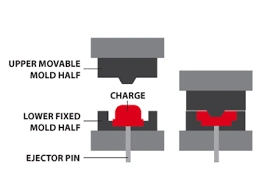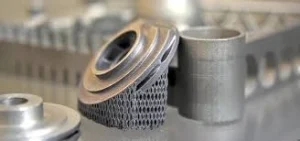A form of reinforced polyester that includes glass or carbon fibers is a sheet molding compound. The resin is commonly epoxy, vinyl ester. It is a polyester that suspends the fibers. They are normally one or longer in length. They have long fibers and strong resin. And they work together to create a durable, cost-effective material. We use a process to create SMC. It guarantees the complete integration of fibers and resin. Manufacturers chop the fibers. They are put into the paste before we apply the resin. It is like a paste on a film. Manufacturers crush the material. They squash it between two sheets. We can do it to get a suitable thickness and texture. Before we sell or utilize it, some points have great importance. We must do proper sheet molding. We can “cure” the compound in storage for a few days. It’s crucial to remember these instructions. We use chopped fibers and resins different reinforcements.
When SMC is put into rolls, there is a complete shape change. We can divide it into smaller parts “charges”. Compression molding is a technique that uses heat and pressure. We can shape charges into anything. We can change straightforward shapes into intricate pieces.
The Compression Molding Process
A “compression molding press” often operates hydraulically. It is where we can do compression molding. The majority of compression molding presses need that SMC loading. This process molds the compound. We can do the final product unloading. Manufacturers do it manually by a veteran operator.
We can sandwich the mold’s upper and bottom parts. They are between two heated plates to form the press. We can fill the lower portion of the mold. We preheat the SMC before molding. Then lower the upper plate.

We can exert pressure on the mold of up to 2000 psi. The SMC spreads and fills the mold. When we apply heat and pressure repeatedly. Therefore, we can use compression molding in many processes. We can also use it to precisely construct extremely intricate objects.
Advantages of SMC
When we compare it to other materials like metals. Even other polyesters like bulk molding compounds (BMC) have their importance. The sheet molding compound’s small weight is its most significant property. It also has a lot of benefits. Because of this, SMC now serves as the principal material. We can use it for many automobile parts. It takes the role of metal components. Additionally, we can use it in the creation of different equipment.
- Spas
- Baths
- Stadium
- Movie theater
- Arena seating
In addition to its lightweight, SMC is easy to manufacture. We can produce it in large quantities. We Combine it with the simple nature of injection molding. In the short production cycle, we can make parts with SMC. We can produce in equal quantities in a short period. But the lightweight nature of SMC involves no compromises in strength. It is robust and durable. It can withstand impacts even at high speeds. The compound is even approved for use on passenger car exteriors. It regularly scores high in crash tests.
In conclusion, sheet molding is a very cost-effective choice. From minimal labor costs to reduce waste. Manufacturers can save money in every part of the engineering process. As we can add the bonus. SMC also saves time. We can prepare it in the mold. Instead of waiting for the molding to finish. Though, a post-mold painting process requires reaching an A-grade finish. The introduction of SMC was rightly a revolution. In revolution, foreshadowing the transition from metals to polymers. Even today, SMC is a solid choice with many attractive benefits. However, there is something that does what SMC and injection molding do even better. It is a “long fiber injection”.
Long Filament Injection Modeling
Long filament injection molding is an even shorter and more efficient process. It is a cost-effective process. We can use it to create highly complex and detailed parts. It shares many of the benefits of SMC. It outperforms SMC in several key zones. Since Romeo RIM brought the process to America in 1999. It has gained massive popularity. We can use it in auto parts, bodywork, furniture, and more. “Long Filament Injection” comprises polyurethane mixed with glass fibers. The name suggests we use longer fibers to add reinforcement and strengthening. We inject the fiber-polyurethane mixture directly into the mold. The molding process uses lower pressure. Its “P” is less than traditional compression molding. We can complete it in minutes. The resulting product is suggestive – approximately 40%. It is lighter than SMC. It is more than 60% lighter than metals.
Examples
- Steel
- Aluminum
Despite its lighter weight, it offers the same strength. It also offers durability and quality as heavyweight polyester.
By choosing LFI, we can save even more in the casting process with SMC. The entire process, from filling the mold to removing the finished product is automatic. We can perform it with the accurate and efficient Romeo RIM robot. In addition, Romeo RIM uses the world’s largest LFI press. We can use it to quickly and easily produce parts up to 12 feet by 12 feet.

The amount of waste or scrap is almost zero. It is quite helpful in maintaining a clean environment. It follows the rules of green chemistry.
Anything SMC can do, LFI can do better!
- It has a short production cycle
- It can create complex parts, including B-side geometry
- It has an impact resistance.
- It has a role in In-mold painting
LFI is even more suitable for in-mold painting than other materials. LFI produces grade-A products. It finishes directly from the mold. Do you want a lustrous or bumpy finish? Don’t worry—LFI can even mimic fine surfaces like pebbles and wood grain. Whether someone is formulating car façades, spas, or siding for a brand-new home, LFI is the right choice.
Requirements
SMC materials are short in range as compared to composite materials. As it is a complicated process. It requires handy labor. It requires a large investment.
